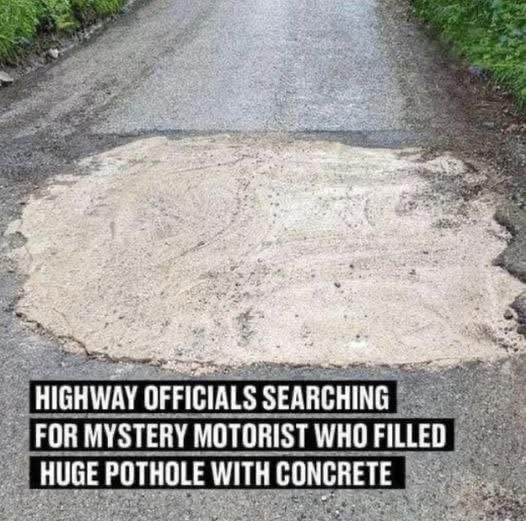In Cornwall, England, a frustrated motorist has sparked a wave of public discussion and official concern after taking it upon themselves to repair a pothole that had gone untouched for weeks. The incident occurred at the intersection of Tanhouse Road and Bodmin Hill in the town of Lostwithiel, where the road had been officially closed since April due to drainage problems that had caused serious deterioration.

Despite the closure and promises of repairs, the area remained untouched for an entire month, leading to growing frustration among local residents and drivers who had to deal with detours and disruptions to their daily routines. Finally, in May, someone who had clearly grown tired of waiting for action decided to take matters into their own hands. Over the course of a weekend, this anonymous individual filled the pothole with cement, temporarily restoring the road’s functionality and allowing it to reopen for use. While many residents saw the act as a helpful, even heroic gesture, the local government did not share the same enthusiasm.
As soon as the Cornwall Council’s road maintenance company, Cormac, discovered the unsanctioned repair, they moved quickly to close the road again, citing safety concerns and the fact that the repair had not been carried out according to official guidelines. According to officials, while the pothole was indeed filled, there was no way to confirm the quality or long-term durability of the materials used, which could pose risks to motorists if left unchecked. As a result, Cornwall Highways has now launched an investigation to identify the person responsible for the unofficial fix.
The road remains closed and is not expected to reopen until June 9, as Cormac works through a backlog of other pending road repairs across the region. This incident has stirred significant public debate. Many locals have expressed support for the mystery motorist, saying that their decision to fill the pothole represents the kind of initiative that is often missing in public infrastructure services. People are frustrated with what they see as slow-moving bureaucracy and a lack of urgency when it comes to fixing basic problems like potholes. To them, the impromptu repair was not reckless, but necessary.
On the other hand, government officials argue that while frustration is understandable, taking roadwork into your own hands can actually make things worse. Patching a road without understanding the underlying structural issues or without following safety codes might result in an unstable fix that could fail unexpectedly, potentially putting drivers at risk. Colin Martin, the Cornwall councilor representing Lanreath and Lostwithiel, addressed the situation candidly. He stated that the pothole itself has become “a perfect metaphor for the way that the entire public sector is crumbling due to underinvestment.” His statement reflected the broader issue at hand—not just the single pothole, but what it represents about the state of public services and funding. Martin’s comments resonated with many in the community who believe that government departments are too underfunded and overwhelmed to respond effectively to everyday infrastructure problems. The debate continues to grow online and in local discussions, with people weighing the risks of unauthorized fixes against the reality of waiting months for official repairs. While some worry that allowing individuals to take on such tasks could lead to dangerous precedents, others see it as a sign of civic responsibility and action in the face of government inefficiency. The identity of the mystery repair person remains unknown, but their actions have left a lasting impact, forcing both the public and officials to confront hard questions about the current state of infrastructure and the responsibility of local governments to respond promptly to community needs. Whether the person will be found or face any consequences is yet to be seen, but their actions have brought attention to an issue that stretches far beyond one pothole, highlighting the gap between public expectations and government capabilities.





